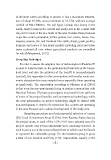Page 670 - 2015-37
P. 670
in the state varies according to season. It has a maximum tempera-
ture of about 29-380c and a minimum of 18-270c with the average
rainfall of 400-1300mm. The soil types include clay loamy in the
south, sandy loamy in the central and sandy soil in the central with
clay soil in most of the low lands of the area. Katsina State produces
crops like cotton groundnut, millet, guinea corn, maize, beans, rice,
cassava, sesame, etc. and livestock like cattle, sheep, goats, poultry,
donkeys and horses. It has many markets including rural and urban
types scattered all over where agricultural products are assembled
for sale (Mohammed, 2013).
Sampling Technique
In order to assess the adoption rate of technologies in Fadama III
project in Katsina State on the participants (treatment) at the house-
hold level and also the spillover of the beneit to non-participants
(control), the respondent in the communities with similar socio-eco-
nomic characteristics were sampled more especially those operating
at small scale. The expectation according to Nkonya et al (2010)
is that even the non-participants living in similar communities with
National Fadama III project participants may beneit from spillover
of some of the project beneits, such as improved technology, while
the new information on project technology might be shared with
non-participants. It need to be noted that few women are operating
in the area because socio-cultural background of the study area.
Sampling procedure involved purposeful selection of twenty
(20) Local Government Areas (LGAs) from Katsina States that are
the project areas, in each of the LGA, FUG were selected were the
project operate and seven respondents were randomly selected. In
each location out of the seven selected three of which must be female
to represent the vulnerable group. For the treatment group it gives
a total of one hundred and forty (140) respondents, equally in the
-5-

